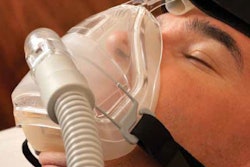
The latest draft handbook for certified medical examiners no longer contains previously proposed details on screening and treating sleep apnea that were part of a prior draft. The withdrawal of those detailed recommendations alarmed some members of the Federal Motor Carrier Safety Administration's Medical Review Board, which met May 20.
"These medical examiners would be in a terrible position if we didn’t arm them" with the detailed tools needed to do their job, said board member Dr. Albert Osbahr. He is medical director for occupational health services at Catawba Valley Medical Center in North Carolina. "Industry doesn’t like it, but they’re not the ones doing the exam. It’s myself and colleagues who are on the firing line."
During the last, April 2020 meeting of the MRB on its medical certification program, a draft handbook emerged online that the board was discussing. The handbook included details on how to screen, test, treat and monitor drivers with regard to sleep apnea. It included the details of recommendations drafted in 2016 by the MRB in part with the Motor Carrier Safety Advisory Committee of industry, advocates, labor and enforcement representatives.
The handbook the review panel of doctors is considering in this week's meeting, however, does not include those detailed recommendations, following Overdrive reporting last year that showed evidence of some medical examiners using the new draft handbook as if it were a final, printed update.

The current, long-approved handbook actually contains even less information than the draft handbook considered in today's MRB meeting. That latest draft limits apnea information to a list of risk factors and other details about the condition. It includes this emphasis regarding obstructive sleep apnea:
The FMCSRs do not include requirements for MEs to screen CMV drivers for OSA, or provide criteria [on or about] whether to refer a driver for OSA testing, diagnostic testing methods, treatment methods, or criteria by which to assess compliance for obstructive sleep apnea treatment.
Board member Michael Kelley, senior medical director of ambulatory services with OhioHealth Neighborhood Care, which operates a small network of sleep centers among other services, worried the approach taken would result in a turn away from the emphasis on sleep apnea in medical certification that is common among examiners today. Kelley and other board members recognized their hands were tied to an extent, given the close attention the industry and Congress has put on the need for full regulatory rulemaking to address apnea substantively.
Kelley remained concerned that a "political process has had so much influence on a medical problem." He suspects that after the update, "it will be very rare for drivers here on out to be tested and treated for sleep apnea unless they truly want to be."
[Related: Evidence emerges of stricter approach -- and more confusion -- around sleep apnea screening]
At once, the medical examiner handbook doesn't exist in a vacuum. An explosion in apnea testing and treatment among commercial drivers has occurred over the last decade with no formal regulatory guidelines driving it.
The paragraph highlighted as problematic by Kelley and others was not new, just new to the handbook, though consistent with past FMCSA statements, as FMCSA Director for Policy Larry Minor pointed out. It had been part of the sleep apnea "bulletin that the FMCSA put out" to medical examiners in early 2015, Minor said. That statement came after pressure from Congress and industry on the agency amid an explosion of apnea screening in medical exams, and confusion around what was required and what wasn't among drivers and examiners.
Still, most MRB members expressed disappointment with the drawback in detail from the draft circulated last year, favoring at least a referential link to the panel's past recommendations.
Board chair Dr. Gina Pervall, also of the Maryland Department of Transportation's Medical Advisory Board, said that the 2016 recommendations came out of not only the MRB but included at least some industry involvement via the Motor Carrier Safety Advisory Committee. "We are providing education throughout this document and we should provide education here," Pervall said. "I don’t understand why we can’t follow it with the work that we did. ... A lot of our recommendations were in conjunction with MCSAC – we came up with this together. We need to include more on evaluation, treatment and compliance with treatment."
"It seems almost criminal it’s not in here," said Brian Morris, the corporate director of medical surveillance for OccMed Consulting & Injury Care.
The 2016 recommended guidelines were drafted when FMCSA was considering a rulemaking (later abandoned) around the condition. Among other things, those recommendations would require any driver with a body mass index measurement of 40 or higher to receive a conditional certification pending results of diagnostic testing for sleep apnea. Other criteria specify a variety of screens for drivers with a body mass index of 33 or higher. The wide net the screens would cast, Overdrive research estimated at the time, might have screened between 25% and 38% of truckers then not being treated for apnea.
Minor emphasized it was likely "we will reference the work from 2016-'17" with at least a link in the handbook, acknowledging "we want to watch out that we’re not going down a slippery slope" with obstructive sleep apnea.
[Related: Is sleep apnea on a path to regulation in trucking?]











